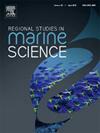一个强大河口岛屿的微塑料污染:分布、影响因素和风险评估
IF 2.1
4区 环境科学与生态学
Q3 ECOLOGY
引用次数: 0
摘要
全球对不同生态系统中微塑料(MP)污染的关注已得到证实,但以生态多样性而闻名的 Nijhum Dwip 岛(NDI)还没有针对 MP 污染程度进行过全面研究。本研究旨在评估位于孟加拉湾北部的 NDI 周围沉积物和地表水中 MP 的空间分布、影响因素和生态风险。从不同地点精心收集了 40 份沉积物和 40 份潮汐水样本,以便进行详细分析。沉积物中 MPs 的平均丰度为 138.39 ± 34.15 个/千克,而水中 MPs 的平均丰度为 72.83 ± 30.76 个/立方米。在 NDI 上观察到的各种形状包括薄膜、碎片、纤维和泡沫,碎片在沉积物(64.05%)和水中(61.51%)占主导地位。傅立叶变换红外光谱分析确定了两种主要聚合物类型,即聚乙烯 (PE) 占 57%,聚丙烯 (PP) 占 40%。结果表明,NDI 的污染水平较高,沉积物和水污染负荷指数分别为 1.32 和 2.01,表明这两个区域都存在严重的 MP 污染。鉴于该岛稀有的生物多样性,废水污水、人为活动和大气沉积物可能是造成水和沉积物中 MP 污染的原因。水体中 MP 与理化性质之间没有很强的相关性,PCA 双图显示了它们相似的分布,而沉积物中 MP 的丰度与 pH 值和有机物显著相关(p<0.05),这表明 MP 在水生环境中的迁移起着关键作用。通过典范相关分析,确定了两个重要的典范变量,这表明取样点的 MP 污染相互依存。这项研究有助于更好地了解 MP 在稀有岛屿中的发生情况,这些岛屿是几乎没有对这类污染进行过研究的生态系统,它还可以报告可持续的干预措施,以减少 MP 对孟加拉湾的输入。本文章由计算机程序翻译,如有差异,请以英文原文为准。
Microplastics contamination through a mighty estuarine island: Distribution, influencing factors, and risk assessment
The global concern over microplastic (MP) contamination in diverse ecosystems is well-established, yet Nijhum Dwip Island (NDI), known for its ecological diversity, has not undergone a comprehensive study addressing the extent of MP pollution. This research aims to evaluate the spatial distribution, influencing factors, and ecological risks of MPs in both sediment and surface water surrounding NDI, situated in the Northern Bay of Bengal. A meticulous collection of 40 sediment and 40 tidal water samples from various sites facilitated a detailed analysis. The mean abundance of MPs in sediment was 138.39 ± 34.15 pieces/kg, while in water, it was 72.83 ± 30.76 pieces/m³. Various shapes observed on NDI included films, fragments, fibers, and foams, with fragments dominating in sediment (64.05 %) and water (61.51 %). Analysis of FTIR spectra identified two primary polymer types, namely polyethylene (PE) at 57 % and polypropylene (PP) at 40 %. The results indicated elevated pollution levels on NDI, with sediment and water pollution load index measuring 1.32 and 2.01, respectively, signifying significant MP contamination in both compartments. Given the island's rare biodiversity, the vicinity of wastewater sewages, anthropogenic activities, and atmospheric deposition, could be behind MP contamination in water and sediments. No strong correlation between MP and physiochemical properties in water and PCA biplots showed their similar distribution, whereas MP abundances in sediment were significantly correlated with pH and organic matter (p<0.05), signifying a pivotal role in transporting MPs in the aquatic environment. Two canonical variables were identified as important by canonical correlation analysis, demonstrating the interdependence of MP contamination at the sample sites. This research contributes to better insights into the occurrence of MP in the rare islands, which are ecosystems that have been hardly examined for this type of pollution, and it can report sustainable interventions to lessen MP inputs to the Bay of Bengal.
求助全文
通过发布文献求助,成功后即可免费获取论文全文。
去求助
来源期刊

Regional Studies in Marine Science
Agricultural and Biological Sciences-Ecology, Evolution, Behavior and Systematics
CiteScore
3.90
自引率
4.80%
发文量
336
审稿时长
69 days
期刊介绍:
REGIONAL STUDIES IN MARINE SCIENCE will publish scientifically sound papers on regional aspects of maritime and marine resources in estuaries, coastal zones, continental shelf, the seas and oceans.
 求助内容:
求助内容: 应助结果提醒方式:
应助结果提醒方式:


